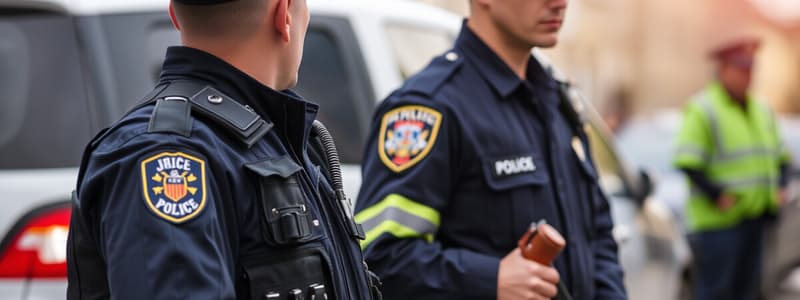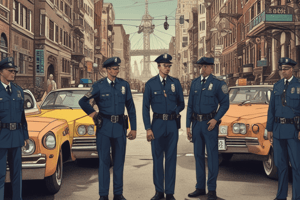Podcast
Questions and Answers
What is ONE of the significant trends in police civil liability litigation since 1960?
What is ONE of the significant trends in police civil liability litigation since 1960?
- Increase in the number of civil suits (correct)
- Fewer judgments against police officers
- Reduction in the number of civil suits
- Decrease in successful litigations
Which of the following is NOT considered a common form of intentional tort against police?
Which of the following is NOT considered a common form of intentional tort against police?
- Wrongful death
- Defamation (correct)
- Invasion of privacy
- Assault and battery
What is the estimated percentage of officers that will be sued?
What is the estimated percentage of officers that will be sued?
- 15 to 25% (correct)
- 5 to 10%
- 50 to 60%
- 30 to 40%
What must be established to claim false arrest?
What must be established to claim false arrest?
What percentage of cases are typically settled outside of court?
What percentage of cases are typically settled outside of court?
Which factor is NOT associated with the negative effects of fears of civil liability?
Which factor is NOT associated with the negative effects of fears of civil liability?
What is identified as a frivolous lawsuit?
What is identified as a frivolous lawsuit?
What time frame can a civil liability case against police typically take from incident to final disposition?
What time frame can a civil liability case against police typically take from incident to final disposition?
What must be established for a defendant to be held liable in a Section 1983 action?
What must be established for a defendant to be held liable in a Section 1983 action?
In which case did the Supreme Court define the concept of 'color of law'?
In which case did the Supreme Court define the concept of 'color of law'?
What doctrine holds that police have no duty to protect the general public absent a special relationship?
What doctrine holds that police have no duty to protect the general public absent a special relationship?
Which case addressed the unreasonable seizure of individuals during an airport drug investigation?
Which case addressed the unreasonable seizure of individuals during an airport drug investigation?
What duty do police have concerning individuals in their custody?
What duty do police have concerning individuals in their custody?
What concept is described by the government being liable for a third party’s victimization due to custody over the plaintiff?
What concept is described by the government being liable for a third party’s victimization due to custody over the plaintiff?
What is the primary obstacle to negligence claims against the police for failure to arrest a drunk driver?
What is the primary obstacle to negligence claims against the police for failure to arrest a drunk driver?
Which legal aspect of police duty requires them to secure accident scenes?
Which legal aspect of police duty requires them to secure accident scenes?
What must a plaintiff prove in a negligence lawsuit against the police besides a special relationship?
What must a plaintiff prove in a negligence lawsuit against the police besides a special relationship?
Which case highlighted the need for police assurance of protection to be enforceable?
Which case highlighted the need for police assurance of protection to be enforceable?
What principle limits recovery for self-inflicted injury or suicide in the context of police duty?
What principle limits recovery for self-inflicted injury or suicide in the context of police duty?
What is a common limitation regarding police conduct in cases involving mental health and suicides?
What is a common limitation regarding police conduct in cases involving mental health and suicides?
In what situation could police liability be heightened due to their failure to act?
In what situation could police liability be heightened due to their failure to act?
Flashcards are hidden until you start studying
Study Notes
Trends in Police Civil Liability Litigation
- Civil suits against police have dramatically increased since the 1960s.
- Successful litigations against police have become more common.
- Many judgments are awarded against police officers, even when they have clean records.
Negative Effects and Fears of Civil Liability
- Civil liability concerns can lower officer morale.
- There can be an erosion of commitment to policing due to fear of lawsuits.
- Officers may feel alienated from the public, affecting community relations.
- Creates barriers to understanding complex policing issues reflectively.
Time Frame for Civil Liability Cases
- Cases can take between 3 to 10 years from the incident to reach a final resolution.
Direct Verdict or Judgment of Law
- This is granted only when there is no evidence to support the jury's verdict.
Civil Litigation Risk Percentage
- Roughly 0.1% of all police encounters with suspects may lead to civil litigation.
Elements of Negligence
- A legal duty exists.
- There is a breach of that duty.
- Proximate cause links the breach to the injury.
- Actual damage or injury must be proven.
Common Forms of Intentional Torts Against Police
- Wrongful death claims.
- Assault and battery allegations.
- Charges of false arrest.
- Invasion of privacy suits.
- Claims of intentional emotional distress.
Criteria for False Arrest Claims
- Police must have willfully detained the individual.
- Detention must be against the individual’s will.
- Must have occurred without proper authority.
- The individual must be aware of their confinement.
Invasion of Privacy Factors
- Involves intrusion into private matters.
- The intrusion must be highly offensive.
- The individual harbors a legitimate expectation of privacy.
Likelihood of Lawsuits Against Officers
- Estimates suggest that 15% to 25% of officers may face lawsuits.
Definition of Frivolous Lawsuits
- A lawsuit is deemed frivolous if it lacks a legal or factual basis.
Unrealistic Fears Among Law Enforcement
- Officers fearing liability may become overly timid and indecisive, affecting their actions in arrests or searches.
Percentage of Lost Lawsuits
- The percentage of lawsuits that are lost by police ranges between 4% and 8%.
Settlements Outside of Court
- Approximately 25% of cases are resolved through settlements outside of the courtroom.
Legal Accountability in Police Pursuits
- Per Justice Marksman, parties fleeing police can be held liable if they cause injury to innocent individuals.
Summary Judgment Motion
- Defendants can file this motion when a plaintiff's case cannot possibly support a jury's consideration.
Acting Under Color of Law
- Section 1983 actions require actors to be under "color of state law" for liability in constitutional violations.
- Defined in West v. Atkins (1988).
Key Cases on Warrantless Search and Seizure
- Terry v. Ohio (1968) - Stop and frisk.
- Carroll v. US (1925) - Search of vehicle with probable cause.
- Horton v. California (1990) - Plain view or open fields doctrine.
- Maryland v. Buie (1990) - Protective sweeps.
- Michigan v. Summers (1981) - Temporary detention during search warrant execution.
Courts' View on Police Operations
- Courts are suspicious of aggressive police tactics, despite police perceptions of drug suspects as dangerous.
Confiscation of Property
- In Hernandez v. Maxwell (1990), police must return money found during searches if no drugs are involved and provide a receipt.
Buffkins v. City of Omaha (1990)
- Officers acted unlawfully when detaining individuals without reasonable suspicion based on unverified tips.
Public Duty Doctrine
- Police generally do not have a duty to protect the public against harm unless a "special relationship" exists.
Special Relationship Doctrine
- Can hold the state liable for third-party victimization when the state has custody of the victim.
Abandonment Cases and Qualified Immunity
- Police often win abandonment cases due to qualified immunity.
White v. Rockford
- Police were liable for leaving children unattended on the roadside after arresting their caretaker.
Assurance of Police Protection
- Liability may arise if police make promises of protection but fail to fulfill them, impacting victims' subsequent safety decisions.
Four Zones of Negligence
- Justifications for pursuit.
- Vehicle operation by police.
- Circumstantial factors during operations.
- External factors influencing outcomes.
Contributory Negligence
- A plaintiff's actions contributing to their injury can bar recovery against police, often reflecting statutory violations.
Barriers to Negligence Claims
- Sovereign immunity and the distinction between ministerial and discretionary functions hinder negligence claims regarding police failure to arrest.
Special Relationships Factors
- Considers intent of legislation and circumstances of the incident to establish potential government liability.
Legal Aspects of Police Duty
- Duties include warning and protecting, rendering assistance, investigating traffic accidents, and securing accident scenes.
Special Duty of Care
- Courts recognize police have a duty of care to individuals in their custody, extending beyond incarceration to other custodial situations.
General Duty of Care
- Rarely results in liability for self-inflicted injuries since these are often seen as intentional acts.
Foreseeability of Suicide
- Courts consider whether police could reasonably anticipate that an injury would occur due to their actions or inactions, influenced by various factors.
Establishing Breach of Duty
- Plaintiffs must show a breach of the special duty on a case-by-case basis to succeed in negligence lawsuits.
Police Supervision Responsibilities
- Courts vary on the required standard of care for detainees, with some necessitating constant supervision based on detainee conditions.
Contributory Negligence in Suicides
- Courts have ruled against contributory negligence, indicating officers had a duty to prevent suicides, particularly in cases involving mental illness.
Qualified Immunity Trends
- As legal principles become clearer, fewer officers will achieve qualified immunity for misconduct.
Courts' Role in Change
- Courts typically reflect societal changes in policing and civil liability rather than leading them, adhering to the "reasonable and prudent" standard.
Studying That Suits You
Use AI to generate personalized quizzes and flashcards to suit your learning preferences.




